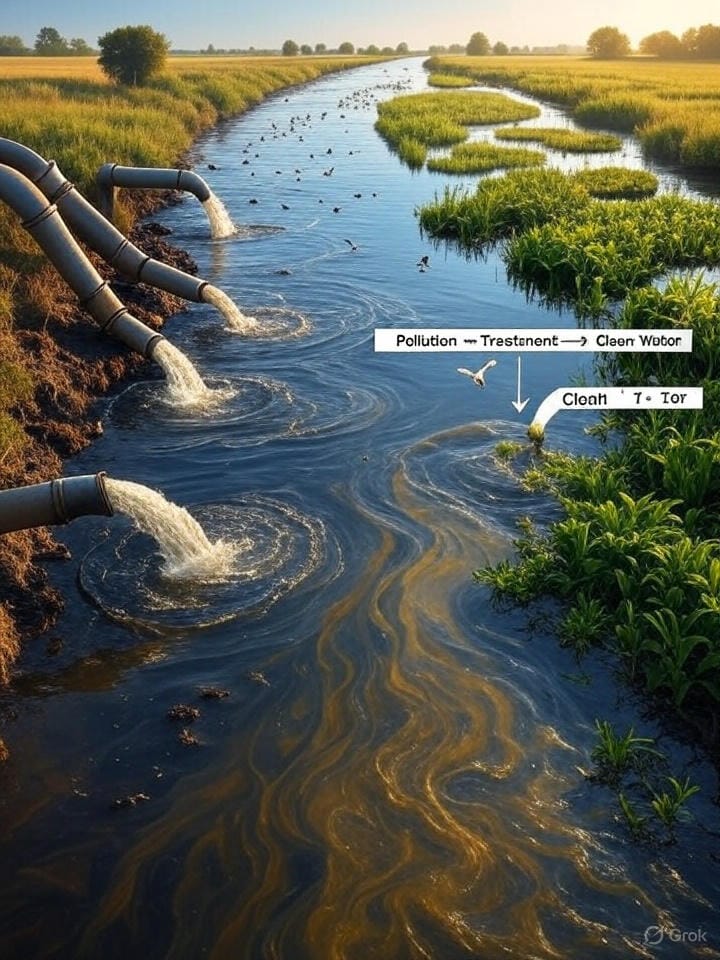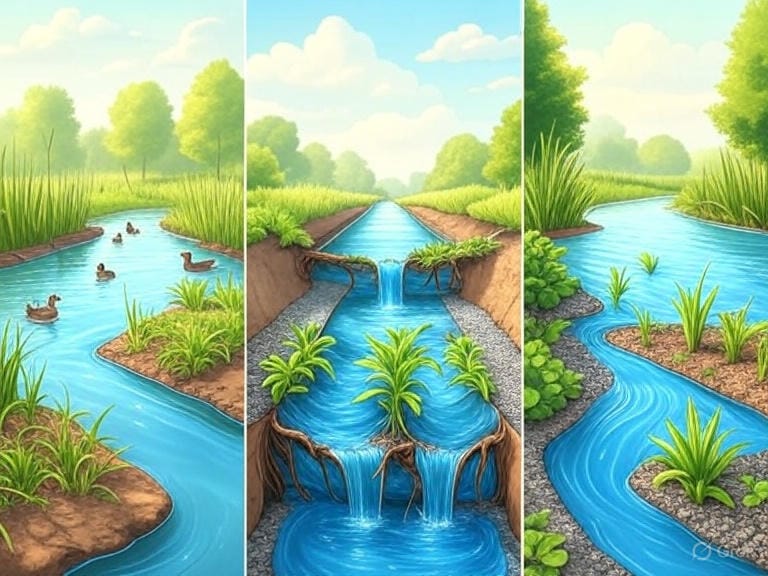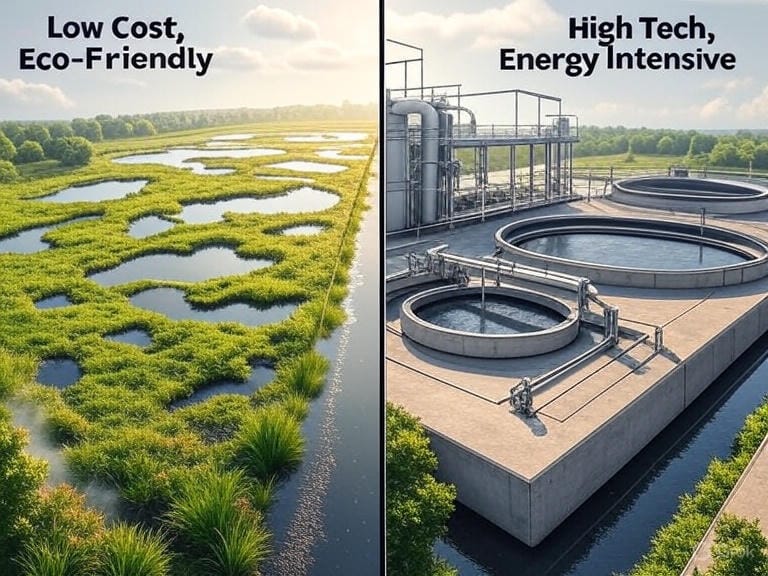
Table of Contents
ToggleGrowing need of sustainable wastewater solution
We know that water is the backbone of life yet the growing crisis of wastewater pollution has become one of the most pressing environmental challenges of our time. Rabbit urbanization, population growth and industrial expansion are generating billions of litres of waste water everyday. Conventional wastewater treatment plants and sewage treatment plants play a crucial role but they are often energy intensive, expensive and inaccessible in rural regions.
This gap in treatment capacity has forced researchers and city planners to explore more sustainable, low cost and eco friendly water purification method and they came up with constructed wetlands for wastewater treatment. This system mimic natural wetlands by using soil, plants and microorganisms to filter and remove contaminants from sewage and industrial effluents.
Constructed wetlands for wastewater treatment treatment follows nature’s process. In recent years they have gained global attention for their ability to handle diverse wastewater streams. They provide effective pollutant removal which minimal energy requirement and they offer benefits such as habitat creation and landscape enhancement. In this article we are going to cover it’s mechanism, types, future and examples.

Mechanisms of constructed wetlands
The efficiency of constructed wetlands for wastewater treatment lies in their ability to combine natural processes which engineered design. Unlike mechanical wastewater treatment plants that rely heavily on chemical dosing and high energy machinery, these constructed wetlands purify water through a combination of biological, physical and chemical mechanism. This processes work simultaneously through which they create a multi barrier system that remove organic matter, nutrients, pathogens and heavy metals from wastewater.
1. Biological Mechanisms
A diverse microbial community lives around plant roots and within the soil matrix In a Constructed wetlands. This micro- organisms perform biodegradation of organic matter and breakdown sewage pollutants into simple & less harmful substances.
Aerobic bacteria which requires oxygen, oxidise organic waste and reduce biochemical oxygen demand. Anaerobic bacteria that works without oxygen convert complex compounds into methane, carbon dioxide and water. Specific microbes facilitate nitrification and denitrification which helps to transform toxic ammonia into harmless nitrogen gas.
Plants themselves also play a vital biological role. Their roots release oxygen into the soil which support microbial life and simultaneously absorb nutrients like nitrogen and phosphorus to prevent eutrophication water bodies.
2. Physical Mechanisms
Constructed wetlands act as natural filters by using soil and substrate layers to trap suspended solids. Wastewater flowing through gravel, sand or soil beds undergoes:
- Sedimentation, where heavy particles settle at the bottom
- Filtration, where fine particles are removed as water passes through substrate pores
- Adsorption, where contaminants adhere to soil and organic matter surfaces
These processes significantly reduce turbidity and suspended solids which is something that conventional sewage treatment plants achieve through high operational costs.
3. Chemical Mechanisms
Chemical transformations within constructed wetlands enhance their purification capacity. This processes include :-
- Precipitation, where dissolved metals (iron, manganese, zinc) form insoluble compounds and settle
- Phosphorus binding, where phosphorus attaches to soil particles or precipitates as calcium or iron salts
- Redox reactions, which helps to degrade organic pollutants and detoxify harmful compounds
Such mechanism allow wetlands to treat not only municipal wastewater but also industrial effluent which contain heavy metals and toxic chemicals.
4. Integration with Other Water Purification Methods
One of the most remarkable aspects of constructed wetlands is their compatibility with conventional water purification methods. They can be used as a primary treatment system in rural areas which lack infrastructure, or as a polishing step which follows large wastewater treatment plants. This flexibility makes them valuable in both urban and rural contexts.
Inspite that wetlands are made for efficiency and scalability They are capable to replicate the cleansing functions of natural ecosystems. By harnessing biological degradation, physical filtration, and chemical transformations, they deliver holistic wastewater purification at minimal cost and energy demand. This multifaceted approach defines their central role in sustainable wastewater management and highlights why they are increasingly adopted.

Types of Constructed Wetlands
Constructed wetlands aren’t a one size that fits all systems. Their design varies which depends on the wastewater source, site conditions and treatment goals. Broadly there are three main types and each with and each with distinct strengths.
Free Water Surface (FWS) Wetlands
It resemble natural marshes with water flowing above the soil surface. Aquatic plants like reeds and cattails dominate it and provide large surface areas for microbial growth. FWS wetlands are especially effective for treating stormwater runoff and polishing effluents from wastewater treatment plants. However, they require more land compared to other designs.
Subsurface Flow Wetlands
In this model, water flows beneath the surface through gravel or soil beds which prevents odor and mosquito problems. Horizontal Flow Wetlands move wastewater across the bed at shallow depths which allows microbes and plant roots to act as natural filters. Vertical Flow Wetlands alternate between flooding and draining to promote higher oxygen transfer and to improve removal of organic matter and nutrients. These systems are compact and suitable as an alternative for small communities, schools, or decentralized sewage treatment plant.
Hybrid Wetlands
Hybrid systems combine both free water surface and subsurface flow designs to maximize efficiency. So in short, wastewater might first pass through a vertical flow wetland for oxygenation and then into a horizontal wetland for nutrient polishing. Such designs deliver high-quality effluents and can handle more complex wastewater streams.
The choice of constructed wetlands of different types depends on land availability, waste water characteristics and treatment goals. Each design provides a sustainable way to transform wastewater into cleaner & safer water.
According to EPA, at a subsurface flow wetland system in Minoa, NY, cyclic operation (flood–drain) doubled the reaction rates for BOD₅ and ammonia removal compared to continuously saturated flow.

Constructed Wetlands vs Conventional Wastewater Treatment Plants
Both constructed wetlands for wastewater systems and conventional wastewater treatment plants serve the same goal which is to remove contaminants from sewage and returning clean water to the environment. However the way they achieve their goal differs.
| Aspect | Constructed Wetlands | Conventional Treatment Plants |
|---|---|---|
| Energy Demand | Operate with minimal power; natural processes drive treatment | Depend heavily on pumps, aerators, and machinery |
| Cost | Low construction and maintenance cost; affordable for small towns | High installation and operational expenses; often requires subsidies |
| Treatment Efficiency | Strong for domestic sewage, stormwater, and agricultural runoff; can reach high BOD/COD removal | Capable of handling complex, large-scale industrial and municipal wastewater |
| Land Requirement | Needs more open land to achieve efficiency | Compact design, suitable for space-constrained urban settings |
| Environmental Impact | Creates green zones, supports biodiversity, enhances landscape | Higher carbon footprint, limited ecological benefits |
| Best Use | Rural and semi-urban communities, polishing step after treatment plants | Large metropolitan areas and heavy industries |
Traditional sewage treatment plants rely on pumps, aerators, and machinery that consume large amounts of electricity. This makes them costly to build and operate especially for small towns. In contrast, constructed wetlands use natural processes like plants, soil and microbes to treat waste water. Their operational costs are much lower and maintenance is simpler.
Model treatment plants can achieve high levels of purification which can handle large volumes of industrial and municipal sewage. Constructed wetlands are less effective in treating highly toxic or very large scale wastewater. However for domestic sewage, storm water and agriculture runoff these wetlands provide comparable results in terms of BOD, COD and nutrient reduction.
A major difference lies in space. Constructed Wetlands need more land area to function efficiently but conventional plants are compact but expensive. Instead of competing these two systems can complement each other. For example, a wastewater treatment plant can handle primary treatment, while a constructed wetland acts as a polishing step.
FAQs
What are constructed wetlands for wastewater
Constructed wetlands for wastewater are engineered systems that mimic natural wetlands to treat sewage, greywater or industrial effluents. They use plants, soil, and microorganisms to filter out pollutants, reduce harmful pathogens, and improve water quality in an eco-friendly way.
Are constructed wetlands for wastewater effective for small communities
Yes becouse They are highly flexible and can be designed for both small villages and large urban settlements. Small communities get benefits most becouse wetlands provide a low cost and low maintenance Alternative to expensive treatment plants.
How much land is required to build a constructed wetlands for wastewater treatment?
The land requirement depends on wastewater volume and type. On average, horizontal flow wetlands may need more space Yet a vertical flow systems require less. Careful design ensures efficiency even in limited land areas.
What are the main advantages of using constructed wetlands
Constructed wetlands for wastewater consume less energy, support biodiversity and enhance the local landscape. Their cost of maintenance is also less as compared to conventional treatment plants. They also provide green spaces that can attract wildlife and benefit the community.
